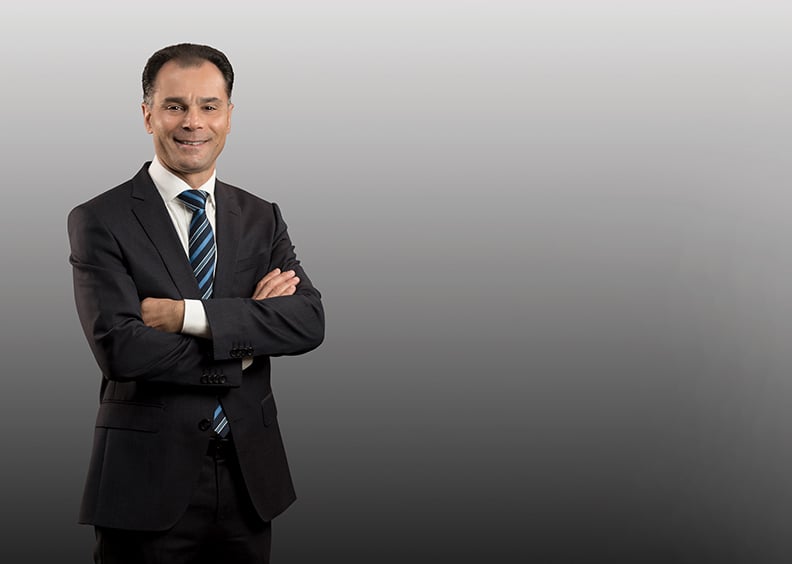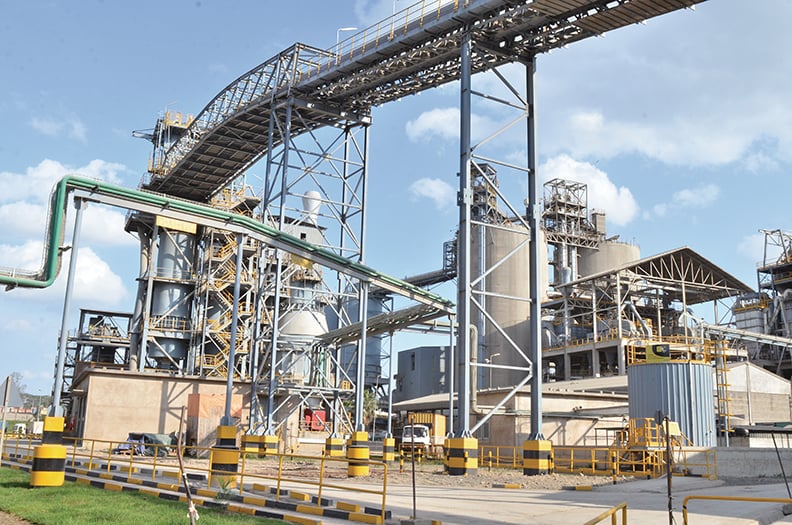Rock steady: Seddiq Hassani
With East Africa on the grow, Managing Director Seddiq Hassani believes his innovative team at Bamburi Cement can provide the foundation of nations.
Many have been entranced by the siren song of the cultural cement mixer that is East Africa. When Croatian construction magnate Felix Mandl arrived in Kenya in 1950, he felt compelled to make the country his home.

The following year, he founded Bamburi Cement in the city of Mombasa. In the years since, the company built success on the pillars of innovation and a culture of inclusivity and collaboration.
Now one of Kenya’s industry captains, Bamburi today bears the ripe fruit of that culture. In fact, its Group Managing Director, Seddiq Hassani, believes people – both inside the company and out – are crucial to the manufacturer’s ongoing success.
"The two legs that a company like Bamburi has to stand on in order to become and remain the leader are innovation and people," Seddiq explains. "People are the most important asset, and at Bamburi we have competent and experienced people."
One of the cement industry’s prolific innovators, Bamburi has set itself an ambitious target more akin to those found in the world of consumer electronics. While Seddiq laments the building material industry’s initial reticence to embrace technology, he says that’s no longer the case – particularly for Bamburi.
"I don’t see Bamburi as just selling cement," he says. "We are a solution provider. The way we’ve designed and built our value proposition to our customers is based on their needs." These needs often depend on sub-Saharan Africa’s varied environments, which can range from benign to aggressive, as well as the constant demand for infrastructure and housing.
The harsh climate and proximity to the Indian Ocean pose unique challenges to the region’s engineers, who often find themselves in the demanding role of nation builders. In 2019, Bamburi launched Duracem, which was expressly engineered to meet the requirements of Kenya’s marine infrastructure projects.
"In the past 12 months, we’ve launched Fundi, a masonry cement that offers an affordable way to plaster and render walls in projects that don’t require premium levels of product sophistication." For every application and need, Seddiq believes Bamburi has a targeted solution.
"We are committed to releasing a new product every year, a new solution every year," he says. "Innovation is part of our DNA. Our Group has the biggest research centre in building materials in the world. It is based in Lyon and will support us to launch a new solution every year. We’ve been successful so far and we’ll continue to be successful. We are also looking at new technologies such as 3D printing and low carbon emission products to contribute to the Net Zero Pledge."

On the other side of the coin is Bamburi’s commitment to environmental rehabilitation. An early product of this effort was Mombasa’s Bamburi Haller Park, a practical demonstration of the possibilities that a dedicated approach to rehabilitation actually bears sustainable results.
The park now acts as a "backyard" for the company’s Mombasa facility, which provides workers and tourists who visit the park with a spectacular backdrop. Bamburi has also worked to reduce its carbon footprint through the manufacture of its newest products.
Its parent company, Swiss-French building materials giant LafargeHolcim, has extended the facilities of its Lyon innovation centre – the biggest of its kind in the world – to the Kenyan team.
"Thanks to LHIC, we’ve solidified our commitment to sustainable environmental practices by developing new cements with the lowest carbon footprint in the region, such as Bamburi Fundi and Bamburi Duracem," Seddiq shares. "These cements contribute to the reduction of greenhouse emissions."
Another area of environmental concern in Kenya is waste management. Uncollected solid waste is a constant and visible problem in the country, with the capital Nairobi hardest hit. LafargeHolcim has also provided Kenya with its waste management brand, Geocycle, which repurposes waste into energy using kilns, a proven technology known as ‘co-processing’.
"Co-processing is an innovative way to clean the environment without causing further emissions and affecting the quality of the products," Seddiq says. By ensuring its product range and manufacturing processes cater to the specific needs of the East African environment, Bamburi enjoys unparalleled brand equity in the region, from Tanzania to South Sudan to Rwanda.
"Bamburi is a very strong brand in this part of the world; it’s well known and appreciated because it is linked to quality, safety and sustainability," Seddiq reveals.
"Based on my 20 years of experience in the industry and in the area, it’s unique to have such strong brand equity in the cement industry, so it’s an asset we need to reinforce." To achieve this, Seddiq has developed a four-pillar plan on which to build Bamburi’s continued success over the next decade.
I don’t see bamburi as just selling cement. We are a solution provider.
"The first pillar is to continue to grow our brand by delivering the best possible solutions to our end users," he says. "It’s harder than it sounds because those range from individual builders to sophisticated ones for ports, dams and airports."
The second pillar is to improve the company’s competitiveness, the key to which, according to Seddiq, is smarter spending. "COVID-19 was an opportunity to review our business model and focus on three priorities: ensure the health of our employees and partners, optimise our cash and reduce our costs," he explains.
"By doing this, we’ve come out of this crisis stronger." The third pillar is the expansion of Bamburi’s clinkering capacity. "Our plan is to follow the trends of Kenya’s needs to better meet demand," Seddiq says. That’s a difficult task given COVID-19.
"However, we do believe in Kenya’s growth and perspectives driven by the Big 4 Agenda. We are, and must remain, the key partner for all our stakeholders, and that means supporting the community. I’m proud that during this COVID-19 period, we’ve been able to help and support all the communities around our plants and operations. We’ve given them masks, handwashing facilities and sanitiser, and embarked on other initiatives to help them face the pandemic. We need to make these four pillars our priority so that we can remain the undisputed leader in our market."
The Health and Safety of its employees and stakeholders has always been at the core of LafargeHolcim’s values, and this was put to the ultimate test as the COVID-19 crisis hit globally. When it did, Bamburi put into action its innovative health and safety systems.
"We have different technologies managing our health and safety," Seddiq points out. "We have digital platforms where managers can track their time spent having health and safety conversations with workers. These conversations are logged with actions identified for follow-up and closure."
The company also has an e-passport where workers can track health and safety training they need to complete to comply with the company’s health and safety standards and procedures. This is monitored for continuous improvement.
"We track every one of our more than 1,000 workers, either direct employees or subcontractors." Its transporters use the digital platform to track and improve driver behaviour through the In-Vehicle Management System, which tracks speeding, harsh braking and acceleration, freewheeling and exceeding driving hours. This is tied to the reward and sanction policy to ensure continuous improvement.
"Digital is an important pillar of our strategy, which is targeting four different areas of the business: the health and safety of employees and contractors; sales, through an app where customers can place orders, follow up their orders and view their statements; logistics, through a system where we manage the safety of drivers by monitoring their behaviour and also optimising turnaround time; and industrial, through different automated systems to improve our efficiency and reduce our costs."
Seddiq has at various times held positions in sectors as varied as finance, procurement, logistics, marketing and sales. "As an engineer, the function I liked most during my 20 years in the Group was in operations, either when I was in charge of the gypsum activity in Morocco or today in Kenya.
However, my current experience in Kenya is by far the most exciting one, for many reasons: I discovered a beautiful country, I work with fantastic people and all together, we are making Bamburi a great company. Upon joining Bamburi, Seddiq was delighted to discover one of the company’s key assets was its people.
We are committed to releasing a new product every year, a new solution every year. Innovation is part of our DNA.
"In my previous role, I’ve had to travel a lot and work with different people from different origins and different cultures, and to me that’s really exciting because you discover so much not only about others, but also about yourself," he confesses.
"It challenges the way you see things." At the same time, the addition of his own expertise and experience to Bamburi’s team made it a two-way conversation. "It has to be two-way to be successful, because as much as you have to manage other people, you have to be willing to listen," he insists.
"You need to stay humble and be eager to learn from others, whatever their position is. "This is what’s great about Bamburi, and what has helped make it the leader in East Africa – the wonderful, very competent people it has."
Proudly supported by: